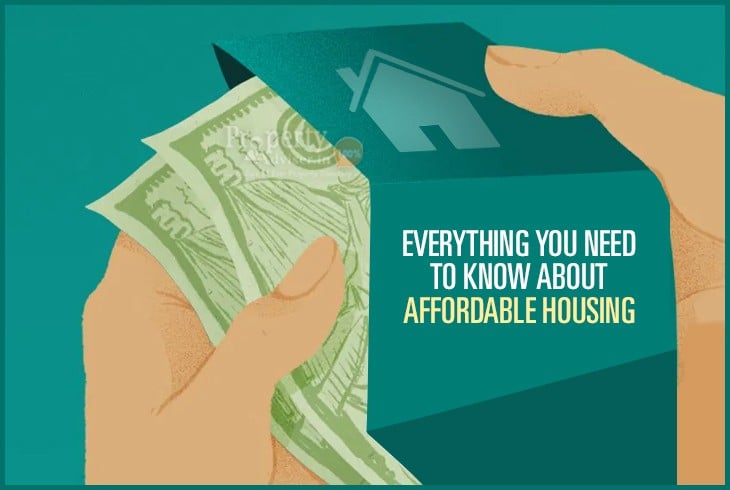What is Affordable Housing?
Is real estate development only about villas, gated communities and luxurious apartments? Are those from low income groups not included in the real estate boom? With an ever-increasing population and skyrocketing costs of real estate, how is it possible for the economically challenged to own a house? Is it possible at all?
Affordable housing in India is all about building and subsidising low-cost housing units and making them affordable for economically weaker sections. Those with low or middle levels of income can also avail of affordable housing. They can dream about owning a house, much like the affluent people do. More so, they can actually go ahead and fulfil that dream!
In this article, we will talk about low-cost housing in India, what is affordable housing, who can avail affordable housing schemes, who is eligible for Pradhan Mantri Awas Yojana, and proposals for affordable housing in India in the Nirmala Sitharaman union budget.
Pradhan Mantri Awas Yojana (PMAY)
The government of India works with state governments to facilitate affordable housing in India for the lower income groups. The benefits are also extended to minority groups like women, widows, senior citizens and transgender community belonging to the lower income group.
PMAY helps economically weaker sections (EWS), lower income groups (LIG) and middle income groups (MIG - I and MIG - II) in the following ways:
- Subsidising the interest component on home loan to the tune of up to ? 2.67 lakh, that varies for each of the beneficiary groups. Interest subsidy for EWS/LIG is 6.50%; for MIG - I, it is 4%; for MIG - II, it is 3%.
- Rehabilitating slums and providing pucca houses
- Providing financial assistance to the tune of ? 1.5 lakhs to EWS families for the purchase or construction of houses.
Pradhan Mantri Awas Yojana (Urban)
With more and more people migrating to urban areas, and housing becoming a challenge, in 2015, the famous scheme called Pradhan Mantri Awas Yojana- Urban (PMAY-U) was launched to fund affordable housing for the urban poor. It is being delivered phase by phase, with the goal of completing 30 million houses by 2022. To that effect, 13.6 lakh in urban areas were already completed by January 2019.
Pradhan Mantri Awas Yojana (Rural)
Additionally, in 2016, PMAY was launched for rural areas, and 1.53 crore houses were completed by January 2019.
Who is Eligible for Pradhan Mantri Awas Yojana?
So, exactly who can apply for PMAY subsidy, and on what kind of property?
- Those households with annual income between ? 3 lakh to 18 lakh.
- Those who do not already own a pucca house in any part of the country.
- PMAY is applicable to self-constructed and builder property.
- Married couples can get a single subsidy, be it joint or single-person ownership.
- Ground floor preference is given to senior citizens and to the differently-abled.
- For EWS/LIG category, the annual household income must be within ? 3 lakh and 6 lakh; the family should comprise husband, wife and unmarried sons and daughters; the property must be co-owned by a female family member.
- For MIG-I and MIG-II groups, the household income must be within ? 6 lakh to 12 lakh, and ? 12 lakh to 18 lakh respectively; a female co-owner of the property is desirable; married and working children count as a separate household.
Also Read - Benefits of Union Budget 2021-22
PMAY cannot be availed in the following situations.
- Those who already own a pucca house anywhere in the country are not eligible.
- PMAY benefits cannot be availed on an existing house.
- PMAY is not applicable on resale flats.
- Those who have already availed a housing benefit from a previous state or central government scheme cannot avail PMAY benefits.
- If the annual income of the household is more than ? 18 lakhs, then PMAY does not apply.
How to Apply for Pradhan Mantri Awas Yojana
Once the eligibility criteria is met, it is easy to apply for PMAY, either online or offline..
- One can apply online on the PMAY website - <https://pmaymis.gov.in/>. A valid Aadhar card is necessary.
- If you want to apply offline, then you can do so at a Common Service Centre (CSC). You need to fill a form that costs ? 25.
After applying, you will receive an application reference number, and you can later on check if your name is on the list of those whose application has been accepted.
- Go to <https://rhreporting.nic.in/netiay/Benificiary.aspx.>.
- Click the Advanced Search button.
- Enter the details.
- If your name is present in the list, you can check the details.
Nirmala Sitharaman Union Budget - Affordable Housing
In a further boost to affordable housing in India, Nirmala SItharaman union budget includes additional benefits.
- Extension for the Rs 1.5 lakh benefit on interest paid on affordable housing loans by one year to March 31, 2022. (Last year this was extended by a year to March 2021 from March 2020 earlier).
- Tax holiday for one more year – till 31st March, 2022.
- Deduction under Section 80IBA of the Income Tax Act.
- The FM has also proposed to extend the date of loan sanction for availing this additional deduction by a year to March 2022 from March 2021 earlier, so that more people can avail this benefit.
- Committed to promoting supply of affordable rental housing for migrant workers, Nirmala Sitharaman union budget proposed to allow tax exemption for notified affordable renting projects.
Experimental Low Cost Housing in India
With increased urbanisation leading to a demand for low cost housing in India, realtors are developing low-cost housing projects in “leapfrogged” locations - meaning in locations far away from the main town. A lot of developers like Tata Housing, Mahindra Lifespaces, Patel Realty and VBHC have developed low-cost houses in various states, including Maharashtra and Gujarat
Innovative entrepreneurs are experimenting and developing low cost housing in India using recycled materials, prefabricated structures, energy efficient and environment friendly materials, rat-trap bond walls, concrete blocks instead of bricks, arched foundation and so forth.













